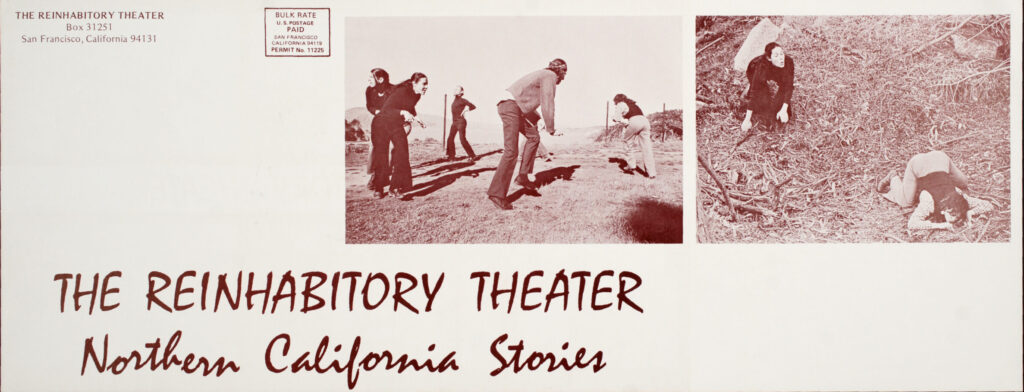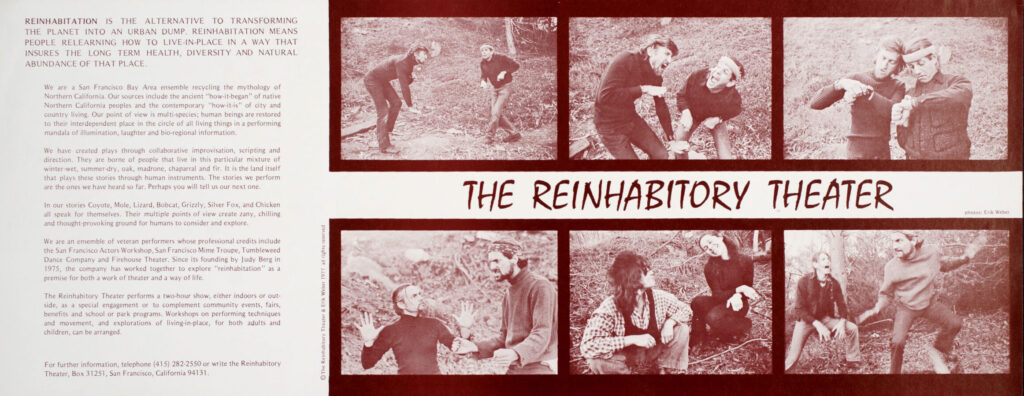The 1970s were a time of reevaluating social values and considering appropriate modes for long term existence in particular life-places (bioregions.) In California, the first peoples had dynamic interactive relationships with all aspects of the ecology; Europeans brought industrial ecological exploitation for gold and other “resources.” As people began redicovering non-industrial ways to relate to each other and the places they lived, reinhabitory considerations emerged.
“Reinhabitation means learning to live-in-place in an area that has been disrupted and injured through past exploitation. It involves becoming native to a place through becoming aware of the particular ecological relationships that operate within and around it. It means understanding activities and evolving social behavior that will enrich the life of that place, restore its life-supporting systems, and establish an ecologically and socially sustainable pattern of existence within it. Simply stated it involves becoming fully alive in and with a place. It involves applying for membership in a biotic community and ceasing to be its exploiter. and respecting the values the first peoples.”
—Peter Berg
The Reinhabitory Theater was concerned with developing long term sustainable relationships with the bioregions (life-places) where people lived—the theater was a tool for social and political change. It engaged local communities in the experience of living from a bioregional perspective. The Reinhabitory Theater was created as an expression of and support for the emerging Northern California social explorations grounded in nature.
The Reinhabitory Theater group researched and explored stories about place, stories about relationships, and stories about reality. Most stories originated from Northern California culture—both contemporary and indigenous. The stories often included both human and other animal species. The scripts made no distinction between species—human to human, lizard to coyote, coyote to silverfox, chicken to human. Characters and species were distinguished by their movements and how they related to each other. Animal masks and animal costumes which would have separated humans from other species weren’t used.
Because the actors just wore everyday clothing, they were anonymously part of the audience until they stepped on stage (if there was one) and began performing. This led the audience to feel very little separation from the actors; the actors were approachable and it seemed that anyone could just stand up and begin acting.
Performances were followed by community empowerment workshops that explored present-day affects (both good and bad) by humans on the place and opened up discussions about practical ways people could live there without damaging the ecosystem and begin restoring damaged aspects of it. Because the actors were so accessible, audiences were excited to participate in the community workshops.
Performances invoked the interdependence of all species, including human beings, and the stories were outrageously unrestrained and very funny. Scripts were open to actors’ improvisations and used references, puns, slang and jokes specific to the English language and Northern California.
When we created the Reinhabitory Theater we researched the place and the animals and how traditional people related to them. Then we experimented with theater techniques that could express living-with-the-place and the problems and delights that could arise. A lot of it was very funny, some was quite serious. We included music, movement, a paper movie and poetry.


The text from the flyer for The Reinhabitory Theater is:
Northern California Stories
REINHABITATION IS THE ALTERNATIVE TO TRANSFORMING THE PLANET INTO AN URBAN DUMP. REINHABITATION MEANS PEOPLE RELEARNING HOW TO LIVE-IN-PLACE IN A WAY THAT INSURES THE LONG TERM HEALTH, DIVERSITY AND NATURAL ABUNDANCE OF THAT PLACE.
We are a San Francisco Bay Area ensemble recycling the mythology of Northern California. Our sources include the ancient ‘how-it-began’ of native Northern California peoples and the contemporary ‘how-it-is’ of city and country living. Our point of view is multi-species; human beings are restored to their interdependent place in the circle of all living things in a performing mandala of illumination, laughter and bio-regional information.
We have created plays through collaborative improvisation, scripting and direction. They are borne of people that live in this particular mixture of winter-wet, summer-dry, oak, madrone, chaparral and fir. It is the land itself that plays these stories through human instruments. The stories we perform are the ones we have heard so far. Perhaps you will tell us our next one.
In our stories Coyote, Mole, Lizard, Bobcat, Grizzly, Silver Fox, and Chicken all speak for themselves. Their multiple points of view create zany, chilling and thought-provoking ground for humans to consider and explore.
We are an ensemble of veteran performers whose professional credits include the San Francisco Actors Workshop, San Francisco Mime Troupe, Tumbleweed Dance Company, and Firehouse Theater. Since its founding by Judy Berg (AKA Judy Goldhaft) in 1975, the company has worked together to explore “reinhabitation” as a premise for both a work of theater and a way of life.
The Reinhabitory Theater performs a two-hour show, either indoors or outside, as a special engagement or to complement community events, fairs, benefits and school or park programs. Workshops on performing techniques and movement, and exploration of living-in-place, for both adults and children can be arranged.”
The Reinhabitory Theater performers included: Peter Berg, Nina Blasenheim, Peter Coyote, Theresa Dickinson, Judy Goldhaft, Jim Griffiths, Christie Hakim, Marlowe Hotchkiss, Muneira Kadrie, Lenore Kandel, Kush, Kent Minault, and Aaron Rosenberg.
Earliest performances were in conjunction with the Winter Solstice 1975 in Glen Canyon Park (San Francisco) and the Vernal Equinox 1976 in a shell mound meadow near Buckeye Canyon on San Bruno Mountain. The theater rehearsed at The Farm, a community space in San Francisco.
Peter Berg’s essay “Reinhabitory Theater” appeared in Reinhabiting a Separate Country, 1978, Planet Drum Books along with a script and photos from The Reinhabitory Theater taken by Eric Weber, Shafi Hakim, Judi Quick, Edmund Shea, and others. Performances were held in a variety of Northern California locations in situations ranging from meadows, Grange halls, pastures, schools, to theaters. Performances were usually held in conjunction with community organizing workshops.
More about the Reinhabitory Theater from FoundSF

Reader Interactions